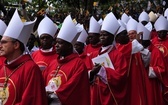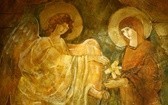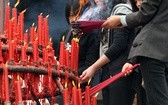Zaginione plemiona Izraela
Rastafarianizm stanowi jedno z nowych zjawisk religijnych. Interpretowany jest często, jako proces poszukiwania tożsamości etnicznej, rasowej i kulturowej w nowej formie ekspresji religijnej, wyrosłej na podłożu judeo-chrześcijańskim.
240. A. Peck, Teleewangelizm..., op. cit., s. 169-190.
241. H. Lee, S. Dayis, The firsl Rasta: Leonard Howell and the rise of Rastafarianism, Chicago 2003, s. 27-32.
242. Ibidem, s. 32-33: „One of the followers remembers that only one time did he witness a sacrifice performed by Howell. He reportedly threw a living lamb into a bonfire but close enough to the edge to allow the lamb to escape - probably with the intent to create a new parable that the lamb was ultimately to escape the fire and tribulation. But his followers misunderstood his gesture, and they caught the animal and threw it back in. Howell ran to the rescue of the lamb, but it was too late".
243. N. L. Erskine, From Gamey..., op. cit., s. 41-42.
244. Ibidem, s. 37; J. G. Mclton, Encyclopedia of American religions, wyd. 6, Detroit 1999,
s. 852 (nr 1857).
245. Ibidem, s. 852.
246. http://www.jamaicaobscrver.com/columns/html artykuł L. Moyston, Leonard P. Howell, universal prophet.
247. B. Chevannes, Between the Living and the Dead: the Apotheosis of Rastafari Heroes [w:] Religion, diaspora ..., op. cit., s. 337; G. Hausman, The Kebra nagast: the lost Bibie of Rastafarian wisdom and faith from Ethiopia and Jamaica, New York 1997, s. 7.
248. N. L. Erskine, From Garvey..., op. cit., s. 63-64.
249. O. Lakę, RastafarI Women..., op. cit., s. 60.
250. Biblia Tysiąclecia, Księga Psalmów, s. 699.
251. N. L. Erskine, From Garvey..., op. cit., s. 67-68.
252. Podstawą był brytyjski tekst, E. A.Wallis Budge, The Queen ofSheba & her only son Menyelek: being the history of the departure of God & his Ark of the Covenant from Jerusalem to Ethiopia, and the establishment oft he religion of the Hebrews & the Salomonie line of kings in that country: a complete translation ofthe Kebra Nagast with introduction, London 1922; polskie wydanie, S. Strelcyn, M. Rudnicki, Kebra nagast czyli Chwala królów Abisynii: fragmenty, Państwowe Wydawnictwo Naukowe, Warszawa 1956.
253. G. Hausman, The Kebra nagast: the lost Bibie of Rastafarian wisdom and faith from Ethiopia and Jamaica, New York 1997, s. 172-196.
254. Ibidem, s. 16,20.
255. N. L. Erskine, From Garvey..., op. cit., s. 44-48.
256. G. Hausman, The Kebra nagast..., op. cit., s. 103-110.
257. P. B. Clarke, Blackparadis..., op. cit., s. 13, 32, 35-46; G. E. Simpson, Carribean Religions [w:] The Encyclopedia of Religions, red. M. Eliade, t. 3, s. 95-97; E. Pullen, Rastafarianism [w:] Encyclopedia of African-American Religiom, red. L. Murphy, J. Melton, G. Ward, NewYork-London 1993, s. 632-637.
258. W tłumaczeniu Biblii Tysiąclecia, Księga Psalmów, s. 629, użyta jest nazwa Kusz a nie Etiopia.
259. Biblia Tysiąclecia, Księga Jeremiasza, s. 924.
260. Ibidem, Księga Apokalipsy, s. 1401.
261.Ibidem, s. 1413.
262. L. Barrett, The Rastafarians: the Dreadlocks ofJamaica, Kingston 1981, s. 80: tłumaczenie autorki.
263. G. Hausman, The Kebra nagast..., op. cit., s. 113: „The sun came down from heaven to the country of Judah and it lighted it upon more brilliantly than before. But the Israelites paid no heed to it and they even wished to extinguish its light and now it rose below the earth in an unexpected place. It illuminated the country of Ethiopia".
264. N. L. Erskine, From Garvey..., op. cit., s. 60.
265. H. Lec, S. Davis, Thefirst Rasta..., op. cit., s. 48-49.
266. J. G. Melton, Encyclopedia of American..., op. cit., s. 852.
267. G. Hausman, The Kebra nagast..., op. cit., s. 45-48.
268. Biblia Tysiąclecia, Księga Apokalipsy, s. 1413.
aktualna ocena | |
głosujących | |
 Ocena |
bardzo słabe |
słabe |
średnie |
dobre |
super |
Ocena |
bardzo słabe |
słabe |
średnie |
dobre |
super |

Alfabet religii: Platon, Arystoteles i... Biblia?
Harmonijne połączenie zalet ludzkich w idealnej wizji poczętej z filozofii Greków.

Alfabet religii: Św. Aretas
Kolebka islamu, himjarycki król, żydowski neofita i pewien mało znany patron.

Alfabet religii: Nowy kształt judaizmu
Kto w tej historii jest lepszym Żydem: ten, który napisał Hagadę na nowo, czy ten, który ją spalił?




















